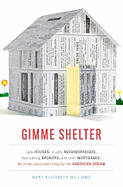
 At the leading edge of what is sure to be a tidal wave of books examining every aspect of the mortgage meltdown, freelance journalist Mary Elizabeth Williams offers a highly entertaining account of her own family's quest to become homeowners at the height of the real estate bubble madness. In 2003, at the beginning of what would become an exhausting three-year process, Williams was gripped by the same desire shared by so many other middle-class families looking to turn their dreams of ownership into reality. "Of course I want a home," she writes. "I'm American; it's encoded in my DNA." Although their incomes were modest, Williams and her husband had excellent credit and savings to draw from. They gave themselves a $400,000 budget, which seems like a reasonable amount until one considers that they were looking for a home in New York City.
At the leading edge of what is sure to be a tidal wave of books examining every aspect of the mortgage meltdown, freelance journalist Mary Elizabeth Williams offers a highly entertaining account of her own family's quest to become homeowners at the height of the real estate bubble madness. In 2003, at the beginning of what would become an exhausting three-year process, Williams was gripped by the same desire shared by so many other middle-class families looking to turn their dreams of ownership into reality. "Of course I want a home," she writes. "I'm American; it's encoded in my DNA." Although their incomes were modest, Williams and her husband had excellent credit and savings to draw from. They gave themselves a $400,000 budget, which seems like a reasonable amount until one considers that they were looking for a home in New York City.Although it afforded zero privacy (there was only one door--in the bathroom) and a kitchen so small she had to turn sideways to open the oven, Williams loved the Brooklyn apartment she shared with her husband and their two small daughters and wanted to stay in the neighborhood. So she traversed the borough, looking at apartments that were unpainted, filthy, miniscule, roofless, unheated and downright dangerous; all of which were well north of her price range. 'It's not the apartment for us," she writes of one hovel. "This is the skank pit you retreat to after the divorce, the apartment where you have a leftover sub for breakfast and Klonopin for dinner, with an inappropriate hookup for a chaser." Williams realized that buying anything bigger than a shoebox in Brooklyn was going to be impossible and so broadened her search to Nyack and then to the outer reaches of Manhattan. When they finally found an apartment in Inwood that they could afford, Williams and her husband had to go through a series of Kafkaesque financial and social machinations to buy it, leaving them wiped out in every way.
Although Williams writes with some hindsight, it was impossible for her not to see--even at the time--that the housing bubble was bound to burst. The inflated prices, unchecked greed and shady mortgage deals that Williams encountered were huge red flags warning of what was to come, and she describes it all with wit, intelligence and a great deal of insight. Most poignantly, Williams illustrates how deep is the need to have a place of one's own--and how far we will go to get it.--Debra Ginsberg
Shelf Talker: An insightful and often laugh-out-loud funny account of the author's quest to buy a home in New York City just as the real estate bubble was about to burst.

